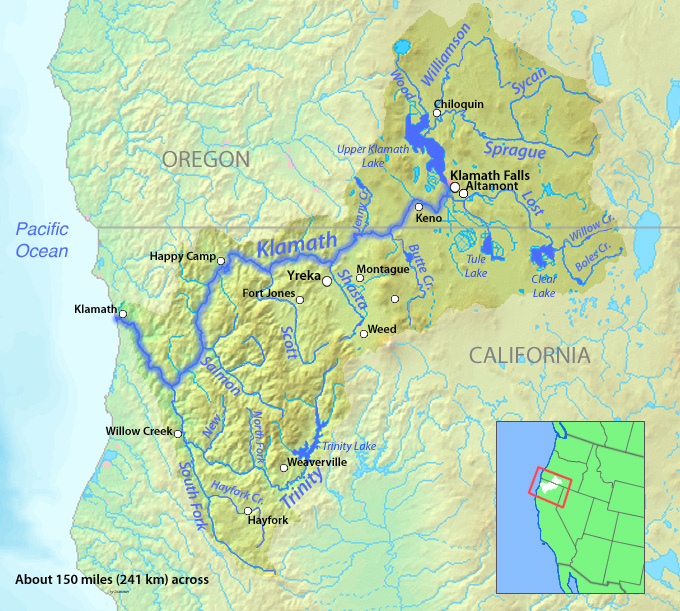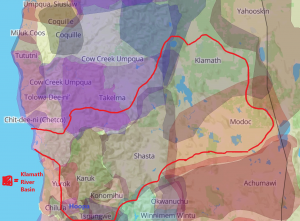Undamming the Klamath: More than Restoring River Flow
|
by Haylee Backs & Nicoletta Dinelli
The Klamath River Basin area runs from so-called Southern Oregon southwest through so-called Northern California until the river feeds into the ocean. The river itself flows through the land of the three Klamath Tribes (the Klamath, the Modoc, & the Yahooskin), and the Shasta, the Karuk, and the Yurok Peoples. It is also important to many more people who live along the river’s tributaries. In 1912, the United States federal government began to dam the Lower Klamath River, eventually constructing a total of four hydroelectric dams that are still there to this day.[1] These dams are owned by PacifiCorp (a subsidiary of Warren Buffet’s company Berkshire Hathaway). The dams are responsible for the deteriorating water quality of the river and threaten the traditions and lifestyles of all who live along and rely on it. For example, in September of 2002, over 60,000 salmon were found dead.[2] This devastation allowed the movement to undam the river, led by the Indigenous Peoples of the area, to gain traction.
The Klamath Tribes live around Klamath Lake and the start of the river. Salmon used to be a staple of their diets, with fresh and dried salmon accounting for nearly half of their consumption. Tribal ancestors recall that before the dams, thousands of pounds of salmon a day could be harvested from the Sprague River.[1] For over a hundred years now, the dams have impeded the salmon from reaching the Upper Basin region.
The Tribes are also worried about the health of their lake. Klamath Lake has been suffering from chronically low water levels and toxic algae blooms, resulting in less spawning and less oxygen in the water. Not only are these conditions harmful to the fish and other organisms in the water, they are also harmful to humans. The lake is considered too toxic to swim in.[3] A lawsuit was filed in favor of more balanced water level management in an attempt to save the C’waam and Koptu fish populations.[3] In 2013, the Klamath Tribes won the lawsuit, granting them water rights and protecting fisheries. In 2014, the Tribes made an agreement with irrigators about water savings and responsible uses.[2] Through long and arduous legal battles, the Tribes have recovered some of the water rights that should never have been taken from them to begin with. And still, the issue of the dams remains.  Drawing of a C’waam (also known as “Lost River suckers”). The Koptu (“Shortnose suckers”) look similar but are smaller with a shorter lifespan.[3] Water is not just a necessity for the physical life of the Hupa Tribe, but their spiritual life as well. The water of the Trinity River Basin has been used for healing, cleansing, and ritual for generations. When the river is unhealthy, the people are unhealthy.[4] Undamming the Klamath River is a necessity for not only the Hupa, but for all Indigenous peoples that rely on it for food, water, and health. The Hupa also want to ensure that once the river is undammed the water will be theirs to control. Despite all the Indigenous work and activism that has gone into the undamming movement, the dams are still in place today. PacifiCorp has been stalling, utilizing drawn-out bureaucratic and legal processes to delay the dam removal until it will benefit them economically, or perhaps until they can justify keeping the dams after all.[2] But this situation is one of urgency, not one that should be delayed. Every day that the dams continue to block the natural flow of the Klamath is another day that the surrounding ecosystems are interrupted and another day that the Indigenous Peoples of the area — the original stewards of that land — are being disrespected and harmed through yet another breach of treaties.
“What binds an ecosystem together is the water that runs through it.” [1] Control of the Klamath River and its tributaries is vital for all Native Peoples that habitat the area because their lifestyles rely on the river. However, control is also critical as many Native Peoples, including the Hupa, view themselves as protectors and stewards of the land in which they live.[6] Having control of the river means having the ability to protect not only their own lifestyles and water rights, but the river itself from being further harmed in the name of progress. UPDATE: The governors of California and Oregon signed a deal on November 17, 2020 to take over the license of the dams from Pacificorp and move towards the dam removal. If approved the project would cost an estimated $450 million dollars.[7]
Sources: [1] “Klamath Tribes: No more delays on dam removal” KLAMATH TRIBES NEWS AND EVENTS https://klamathtribes.org/news/klamath-tribes-no-more-delays-on-dam-removal/ [2] ”Un-Dam the Klamath – Background” Klamathriver.org http://www.klamathriver.org/our-work/un-dam-the-klamath/undam-background/ [3] “Restoring fish and a dying lake…” The Klamath Tribes https://klamathtribes.org/restoring-fish-and-a-dying-lake/ [4] “Stories of the River, Stories of the People: Memory on the Klamath River Basin” Brittani Raquel Orona http://dspace.calstate.edu/bitstream/handle/10211.3/131410/finalThesis.pdf?sequence=1 [5] “Hoopa Valley Tribe Files Lawsuit to Block Federal Water Contracts” Hoopa Valley Tribe News https://www.hoopa-nsn.gov/hoopa-valley-tribe-files-lawsuit-to-block-federal-water-contracts/ [6] “Hoopa Valley Tribe Comprehensive Economic Development Strategy (CEDS) 2016 – 2020” https://www.hoopa-nsn.gov/wp-content/uploads/2016/09/Hoopa-Valley-Tribe_CEDS_Draft_v5_FINAL-APPROVED.pdf [7] “California, Oregon to take over dams controlled by Warren Buffett. The plan: tear them down” The Sacramento Bee https://www.sacbee.com/news/local/environment/article247242289.html |


